Does Addressing Rural Energy Poverty Contribute to Achieving Sustainable Agricultural Development?
Abstract
1. Introduction
2. Literature Review
2.1. Agricultural Sustainable Development and Its Measurement
2.2. Studies on the Influencing Factors of Agricultural Sustainable Development
2.3. Studies on the Nexus of Rural Energy Poverty and Agricultural Sustainable Development
2.4. Literature Gaps
3. Agricultural Sustainable Development Index Construction
4. Model and Data
4.1. Equation Specification
4.2. Data Source
5. Results of the Empirical Analysis
5.1. Benchmark Regression
5.2. Robustness Tests
6. Further Discussion
6.1. The Mechanism Analysis of the Impact of Rural Energy Poverty on Agricultural Sustainable Development
6.2. Regional Heterogeneity Analysis across Different Regions
7. Conclusions and Policy Implications
- (1)
- ASD in China is at a relatively low level but shows a rising trend during the whole period. Also, it is showing a significant strengthening trend from the west to the east.
- (2)
- The results of the empirical analysis imply that the improved REP affects ASD positively, as an increase in REP by one standard deviation promotes ASD by 0.027%. Furthermore, the mechanism analysis indicates that rural energy service availability exerts a negative impact on ASD, while rural energy management completeness plays a positive role in improving ASD.
- (3)
- Through the heterogeneity analysis, the eradication of REP has a greater effect on ASD in the non-major grain-producing areas than in the major grain-producing areas, as the absolute values of the coefficients are 0.053 in the non-major grain-producing areas and 0.012 in the major grain-producing areas.
Author Contributions
Funding
Institutional Review Board Statement
Data Availability Statement
Conflicts of Interest
Appendix A

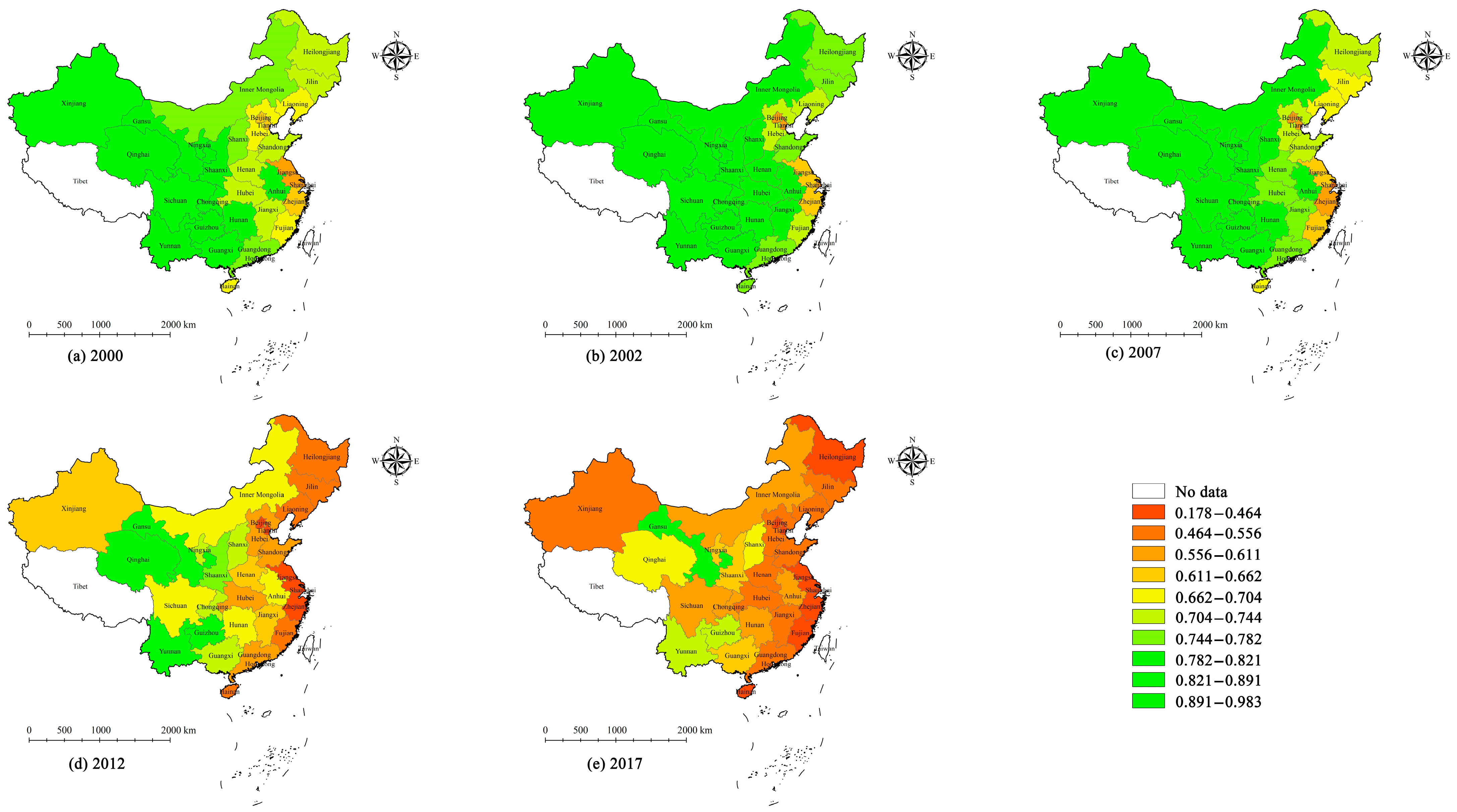
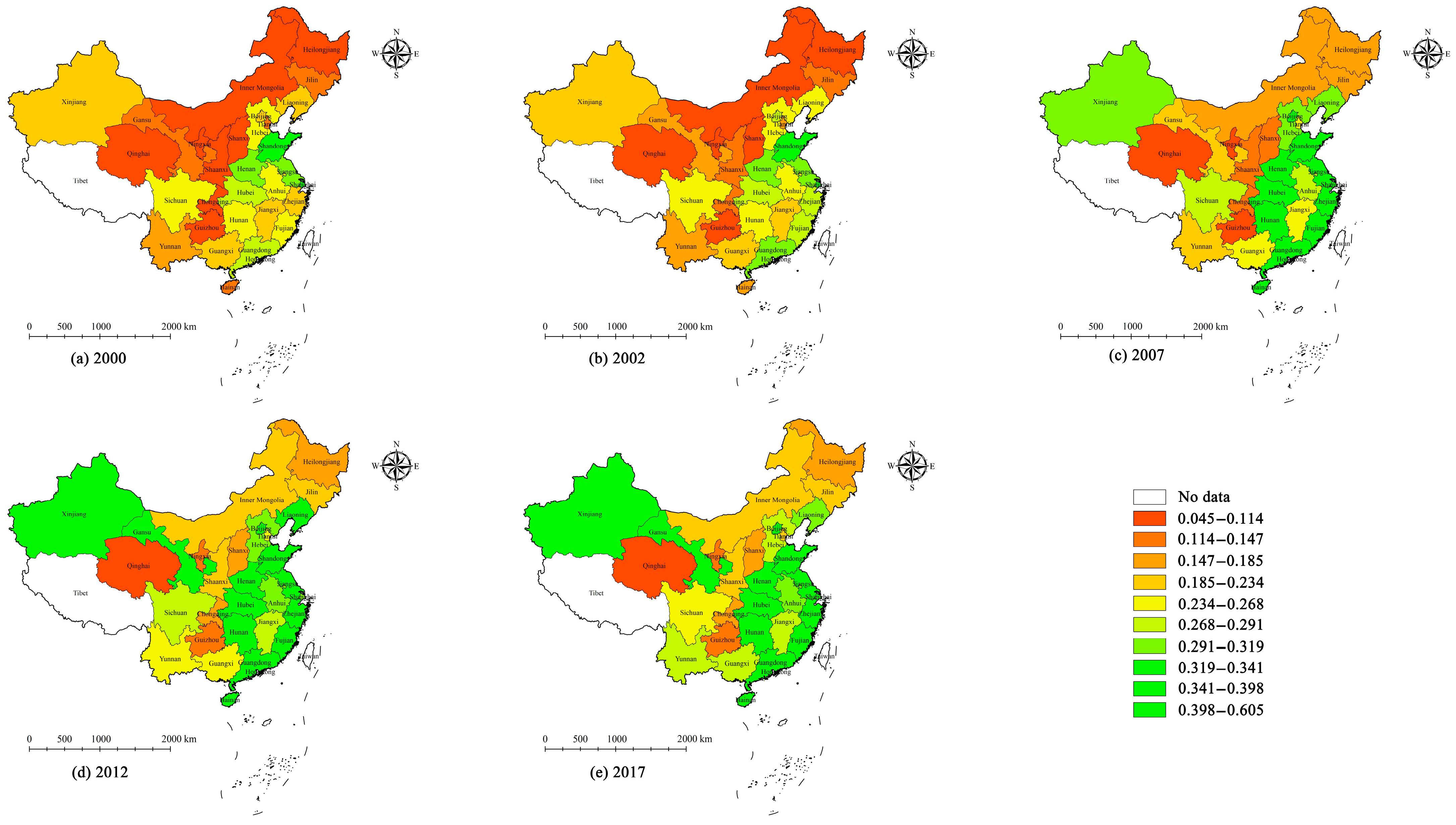
References
- Shen, Z.; Baležentis, T.; Chen, X.; Valdmanis, V. Green growth and structural change in Chinese agricultural sector during 1997–2014. China Econ. Rev. 2018, 51, 83–96. [Google Scholar] [CrossRef]
- Huang, J.K.; Wang, X.B.; Rozelle, S. The subsidization of farming households in China’s agriculture. Food Policy 2013, 41, 124–132. [Google Scholar] [CrossRef]
- Wang, X.; Shen, Y. The effect of China’s agricultural tax abolition on rural families’ incomes and production. China Econ. Rev. 2014, 29, 185–199. [Google Scholar] [CrossRef]
- Yang, Z.; Li, J.; Han, C.; Liu, H. The evolution path of China’s grain production base and the influencing factors. Res. Agric. Mod. 2019, 40, 36–43. [Google Scholar]
- Liu, Y.; Sun, D.; Wang, H.; Wang, X.; Yu, G.; Zhao, X. An evaluation of China’s agricultural green production: 1978–2017. J. Clean. Prod. 2020, 243, 118483. [Google Scholar] [CrossRef]
- Hu, S.; Yang, Y.; Zheng, H.; Mi, C.; Ma, T.; Shi, R. A framework for assessing sustainable agriculture and rural development: A case study of the Beijing-Tianjin-Hebei region, China. Environ. Impact Assess. Rev. 2022, 97, 106861. [Google Scholar] [CrossRef]
- Yanhua, H.; Jianguo, W.; Guohua, Z.; Bingbing, Z. Discussion on rural sustainability and rural sustainability science. Acta Geogr. Sin. 2020, 75, 736–752. [Google Scholar]
- Su, Y.; He, S.; Wang, K.; Shahtahmassebi, A.R.; Zhang, L.; Zhang, J.; Zhang, M.; Gan, M. Quantifying the sustainability of three types of agricultural production in China: An emergy analysis with the integration of environmental pollution. J. Clean. Prod. 2020, 252, 119650. [Google Scholar] [CrossRef]
- Khanal, U.; Wilson, C.; Rahman, S.; Lee, B.L.; Hoang, V.-N. Smallholder farmers’ adaptation to climate change and its potential contribution to UN’s sustainable development goals of zero hunger and no poverty. J. Clean. Prod. 2021, 281, 124999. [Google Scholar] [CrossRef]
- Shen, Z.; Wang, S.; Boussemart, J.-P.; Hao, Y. Digital transition and green growth in Chinese agriculture. Technol. Forecast. Soc. Chang. 2022, 181, 121742. [Google Scholar] [CrossRef]
- Han, Z.; Han, C.; Shi, Z.; Li, J.; Luo, E. Rebuilding the crop-livestock integration system in China—Based on the perspective of circular economy. J. Clean. Prod. 2023, 393, 136347. [Google Scholar] [CrossRef]
- Li, M.; Zhang, K.; Alamri, A.M.; Ageli, M.M.; Khan, N. Resource curse hypothesis and sustainable development: Evaluating the role of renewable energy and R&D. Resour. Policy 2023, 81, 103283. [Google Scholar] [CrossRef]
- Gan, Y.; Liang, C.; Chai, Q.; Lemke, R.L.; Campbell, C.A.; Zentner, R.P. Improving farming practices reduces the carbon footprint of spring wheat production. Nat. Commun. 2014, 5, 5012. [Google Scholar] [CrossRef]
- Liu, D.; Zhu, X.; Wang, Y. China’s agricultural green total factor productivity based on carbon emission: An analysis of evolution trend and influencing factors. J. Clean. Prod. 2021, 278, 123692. [Google Scholar] [CrossRef]
- Zhao, J.; Jiang, Q.; Dong, X.; Dong, K. Assessing energy poverty and its effect on CO2 emissions: The case of China. Energy Econ. 2021, 97, 105191. [Google Scholar] [CrossRef]
- Lin, B.; Wang, Y. Does energy poverty really exist in China? From the perspective of residential electricity consumption. Energy Policy 2020, 143, 111557. [Google Scholar] [CrossRef]
- Churchill, S.A.; Smyth, R.; Farrell, L. Fuel poverty and subjective wellbeing. Energy Econ. 2020, 86, 104650. [Google Scholar] [CrossRef]
- Dong, K.; Dong, X.; Jiang, Q.; Zhao, J. Assessing energy resilience and its greenhouse effect: A global perspective. Energy Econ. 2021, 104, 105659. [Google Scholar] [CrossRef]
- Deng, H.; Jin, Y.; Pray, C.; Hu, R.; Xia, E.; Meng, H. Impact of public research and development and extension on agricultural productivity in China from 1990 to 2013. China Econ. Rev. 2021, 70, 101699. [Google Scholar] [CrossRef]
- Rahman, S.; Salim, R. Six Decades of Total Factor Productivity Change and Sources of Growth in Bangladesh Agriculture (1948–2008). J. Agric. Econ. 2013, 64, 275–294. [Google Scholar] [CrossRef]
- Wang, M.; Xu, M.; Ma, S. The effect of the spatial heterogeneity of human capital structure on regional green total factor productivity. Struct. Chang. Econ. Dyn. 2021, 59, 427–441. [Google Scholar] [CrossRef]
- Hu, Y.; Liu, C.; Peng, J. Financial inclusion and agricultural total factor productivity growth in China. Econ. Model. 2021, 96, 68–82. [Google Scholar] [CrossRef]
- Laurett, R.; Paço, A.; Mainardes, E.W. Sustainable Development in Agriculture and its Antecedents, Barriers and Consequences—An Exploratory Study. Sustain. Prod. Consum. 2021, 27, 298–311. [Google Scholar] [CrossRef]
- Li, M.; Wang, J.; Zhao, P.; Chen, K.; Wu, L. Factors affecting the willingness of agricultural green production from the perspective of farmers’ perceptions. Sci. Total Environ. 2020, 738, 140289. [Google Scholar] [CrossRef] [PubMed]
- Struik, P.C.; Kuyper, T.W. Sustainable intensification in agriculture: The richer shade of green. A review. Agron. Sustain. Dev. 2017, 37, 39. [Google Scholar] [CrossRef]
- DeClerck, F.; Jones, S.; Attwood, S.; Bossio, D.; Girvetz, E.; Chaplin-Kramer, B.; Enfors, E.; Fremier, A.; Gordon, L.; Kizito, F.; et al. Agricultural ecosystems and their services: The vanguard of sustainability? Curr. Opin. Environ. Sustain. 2016, 23, 92–99. [Google Scholar] [CrossRef]
- Bullock, J.M.; Dhanjal-Adams, K.L.; Milne, A.; Oliver, T.H.; Todman, L.C.; Whitmore, A.P.; Pywell, R.F. Resilience and food security: Rethinking an ecological concept. J. Ecol. 2017, 105, 880–884. [Google Scholar] [CrossRef]
- Kazemi, H.; Klug, H.; Kamkar, B. New services and roles of biodiversity in modern agroecosystems: A review. Ecol. Indic. 2018, 93, 1126–1135. [Google Scholar] [CrossRef]
- Koohafkan, P.; Altieri, M.A.; Gimenez, E.H. Green agriculture: Foundations for biodiverse, resilient and productive ag-ricultural systems. Int. J. Agric. Sustain. 2012, 10, 61–75. [Google Scholar] [CrossRef]
- Veisi, H.; Liaghati, H.; Alipour, A. Developing an ethics-based approach to indicators of sustainable agriculture using analytic hierarchy process (AHP). Ecol. Indic. 2016, 60, 644–654. [Google Scholar] [CrossRef]
- Piao, R.S.; Silva, V.L.; del Aguila, I.N.; Jiménez, J.d.B. Green Growth and Agriculture in Brazil. Sustainability 2021, 13, 1162. [Google Scholar] [CrossRef]
- Zhang, H.; Zhang, J.; Song, J. Analysis of the threshold effect of agricultural industrial agglomeration and industrial structure upgrading on sustainable agricultural development in China. J. Clean. Prod. 2022, 341, 130818. [Google Scholar] [CrossRef]
- Chopra, R.; Magazzino, C.; Shah, M.I.; Sharma, G.D.; Rao, A.; Shahzad, U. The role of renewable energy and natural resources for sustainable agriculture in ASEAN countries: Do carbon emissions and deforestation affect agriculture productivity? Resour. Policy 2022, 76, 102578. [Google Scholar] [CrossRef]
- Yang, H.; Wang, X.; Bin, P. Agriculture carbon-emission reduction and changing factors behind agricultural eco-efficiency growth in China. J. Clean. Prod. 2022, 334, 130193. [Google Scholar] [CrossRef]
- Hessari, B.; Oweis, T. Conjunctive use of green and blue water resources in agriculture: Methodology and application for supplemental irrigation*. Irrig. Drain. 2021, 70, 1193–1208. [Google Scholar] [CrossRef]
- Pan, C.; Jiang, Y.; Wang, M.; Xu, S.; Xu, M.; Dong, Y. How Can Agricultural Corporate Build Sustainable Competitive Advantage through Green Intellectual Capital? A New Environmental Management Approach to Green Agriculture. Int. J. Environ. Res. Public Health 2021, 18, 7900. [Google Scholar] [CrossRef]
- Niyigaba, J.; Sun, J.Y.; Peng, D.; Uwimbabazi, C. Agriculture and Green Economy for Environmental Kuznets Curve Adoption in Developing Countries: Insights from Rwanda. Sustainability 2020, 12, 10381. [Google Scholar] [CrossRef]
- Adom, P.K.; Amoani, S. The role of climate adaptation readiness in economic growth and climate change relationship: An analysis of the output/income and productivity/institution channels. J. Environ. Manag. 2021, 293, 112923. [Google Scholar] [CrossRef]
- Shu, J.; Bai, Y.; Chen, Q.; Weng, C.; Zhang, F. Dynamic simulation of the water-land-food nexus for the sustainable agricultural development in the North China Plain. Sci. Total Environ. 2024, 912, 168771. [Google Scholar] [CrossRef] [PubMed]
- Feng, M.; Chen, Y.; Li, Z.; Duan, W.; Zhu, Z.; Liu, Y.; Zhou, Y. Optimisation model for sustainable agricultural development based on water-energy-food nexus and CO2 emissions: A case study in Tarim river basin. Energy Convers. Manag. 2024, 303, 118174. [Google Scholar] [CrossRef]
- Yang, Z.; Solangi, Y.A. Analyzing the relationship between natural resource management, environmental protection, and agricultural economics for sustainable development in China. J. Clean. Prod. 2024, 450, 141862. [Google Scholar] [CrossRef]
- Cheng, Z.; Tani, M.; Wang, H. Energy poverty and entrepreneurship. Energy Econ. 2021, 102, 105469. [Google Scholar] [CrossRef]
- Nie, P.; Li, Q.; Sousa-Poza, A. Energy poverty and subjective well-being in China: New evidence from the China Family Panel Studies. Energy Econ. 2021, 103, 105548. [Google Scholar] [CrossRef]
- Primc, K.; Slabe-Erker, R.; Majcen, B. Energy poverty: A macrolevel perspective. Sustain. Dev. 2019, 27, 982–989. [Google Scholar] [CrossRef]
- Wang, K.; Wang, Y.-X.; Li, K.; Wei, Y.-M. Energy poverty in China: An index based comprehensive evaluation. Renew. Sustain. Energy Rev. 2015, 47, 308–323. [Google Scholar] [CrossRef]
- Acharya, R.H.; Sadath, A.C. Energy poverty and economic development: Household-level evidence from India. Energy Build. 2019, 183, 785–791. [Google Scholar] [CrossRef]
- Amin, A.; Liu, Y.; Yu, J.; Chandio, A.A.; Rasool, S.F.; Luo, J.; Zaman, S. How does energy poverty affect economic development? A panel data analysis of South Asian countries. Environ. Sci. Pollut. Res. 2020, 27, 31623–31635. [Google Scholar] [CrossRef]
- Ozturk, I. The dynamic relationship between agricultural sustainability and food-energy-water poverty in a panel of selected Sub-Saharan African Countries. Energy Policy 2017, 107, 289–299. [Google Scholar] [CrossRef]
- Shi, H.; Xu, H.; Gao, W.; Zhang, J.; Chang, M. The impact of energy poverty on agricultural productivity: The case of China. Energy Policy 2022, 167, 113020. [Google Scholar] [CrossRef]
- Talukder, B.; Vanloon, G.W.; Hipel, K.W. Energy efficiency of agricultural systems in the southwest coastal zone of Bangladesh. Ecol. Indic. 2019, 98, 641–648. [Google Scholar] [CrossRef]
- Nabavi-Pelesaraei, A.; Abdi, R.; Rafiee, S.; Shamshirband, S.; Yousefinejad-Ostadkelayeh, M. Resource management in cropping systems using artificial intelligence techniques: A case study of orange orchards in north of Iran. Stoch. Environ. Res. Risk Assess. 2016, 30, 413–427. [Google Scholar] [CrossRef]
- Parton, W.J.; Gutmann, M.P.; Ojima, D. Long-term Trends in Population, Farm Income, and Crop Production in the Great Plains. BioScience 2007, 57, 737–747. [Google Scholar] [CrossRef]
- Ali, A.; Rahut, D.B.; Behera, B. Factors influencing farmers’ adoption of energy-based water pumps and impacts on crop productivity and household income in Pakistan. Renew. Sustain. Energy Rev. 2016, 54, 48–57. [Google Scholar] [CrossRef]
- Wang, S.; Yang, L. Mineral resource extraction and resource sustainability: Policy initiatives for agriculture, economy, energy, and the environment. Resour. Policy 2024, 89, 104657. [Google Scholar] [CrossRef]
- Azam, A.; Shafique, M.; Rafiq, M.; Ateeq, M. Moving toward sustainable agriculture: The nexus between clean energy, ICT, human capital and environmental degradation under SDG policies in European countries. Energy Strat. Rev. 2023, 50, 101252. [Google Scholar] [CrossRef]
- He, P.; Baiocchi, G.; Hubacek, K.; Feng, K.; Yu, Y. The environmental impacts of rapidly changing diets and their nutritional quality in China. Nat. Sustain. 2018, 1, 122–127. [Google Scholar] [CrossRef]
- Wang, B.; Zhao, J.; Dong, K.; Jiang, Q. High-quality energy development in China: Comprehensive assessment and its impact on CO2 emissions. Energy Econ. 2022, 110, 106027. [Google Scholar] [CrossRef]
- Amoako, S.; Andoh, F.K.; Asmah, E.E. Structural change and energy use in Ghana’s manufacturing and agriculture sectors. Energy Rep. 2022, 8, 11112–11121. [Google Scholar] [CrossRef]
- Song, Y.; Zhang, B.; Wang, J.; Kwek, K. The impact of climate change on China’s agricultural green total factor. Technol. Forecast. Soc. Chang. 2022, 185, 122054. [Google Scholar] [CrossRef]
- Li, J.; Gao, M.; Luo, E.; Wang, J.; Zhang, X. Does rural energy poverty alleviation really reduce agricultural carbon emissions? The case of China. Energy Econ. 2023, 119, 106576. [Google Scholar] [CrossRef]
- Hamilton, B.H.; Nickerson, J.A. Correcting for Endogeneity in Strategic Management Research. Strat. Organ. 2003, 1, 51–78. [Google Scholar] [CrossRef]
- Pesaran, M.H.; Schuermann, T.; Weiner, S.M. Modeling Regional Interdependencies Using a Global Error-Correcting Macroeconometric Model. J. Bus. Econ. Stat. 2004, 22, 129–162. [Google Scholar] [CrossRef]
- Friedman, M. The Use of Ranks to Avoid the Assumption of Normality Implicit in the Analysis of Variance. J. Am. Stat. Assoc. 1937, 32, 675–701. [Google Scholar] [CrossRef]
- Frees, E.W. Longitudinal and Panel Data: Analysis and Applications in the Social Sciences; Cambridge University Press: Cambridge, UK, 2004. [Google Scholar]
- Marques, A.C.; Fuinhas, J.A. Are public policies towards renewables successful? Evidence from European countries. Renew. Energy 2012, 44, 109–118. [Google Scholar] [CrossRef]
- Stock, J.H.; Watson, M.W. Introduction to Econometrics; Addison Wesley Boston: Boston, MA, USA, 2003. [Google Scholar]
- Chen, Z.; Sarkar, A.; Rahman, A.; Li, X.; Xia, X. Exploring the drivers of green agricultural development (GAD) in China: A spatial association network structure approaches. Land Use Policy 2022, 112, 105827. [Google Scholar] [CrossRef]
- Cai, J.; Zheng, H.; Vardanyan, M.; Shen, Z. Achieving carbon neutrality through green technological progress: Evidence from China. Energy Policy 2023, 173, 113397. [Google Scholar] [CrossRef]
- Liu, B.; Tian, C.; Li, Y.; Song, H.; Ma, Z. Research on the effects of urbanization on carbon emissions efficiency of urban agglomerations in China. J. Clean. Prod. 2018, 197, 1374–1381. [Google Scholar] [CrossRef]
- Raihan, A.; Tuspekova, A. Nexus between economic growth, energy use, agricultural productivity, and carbon dioxide emissions: New evidence from Nepal. Energy Nexus 2022, 7, 100113. [Google Scholar] [CrossRef]
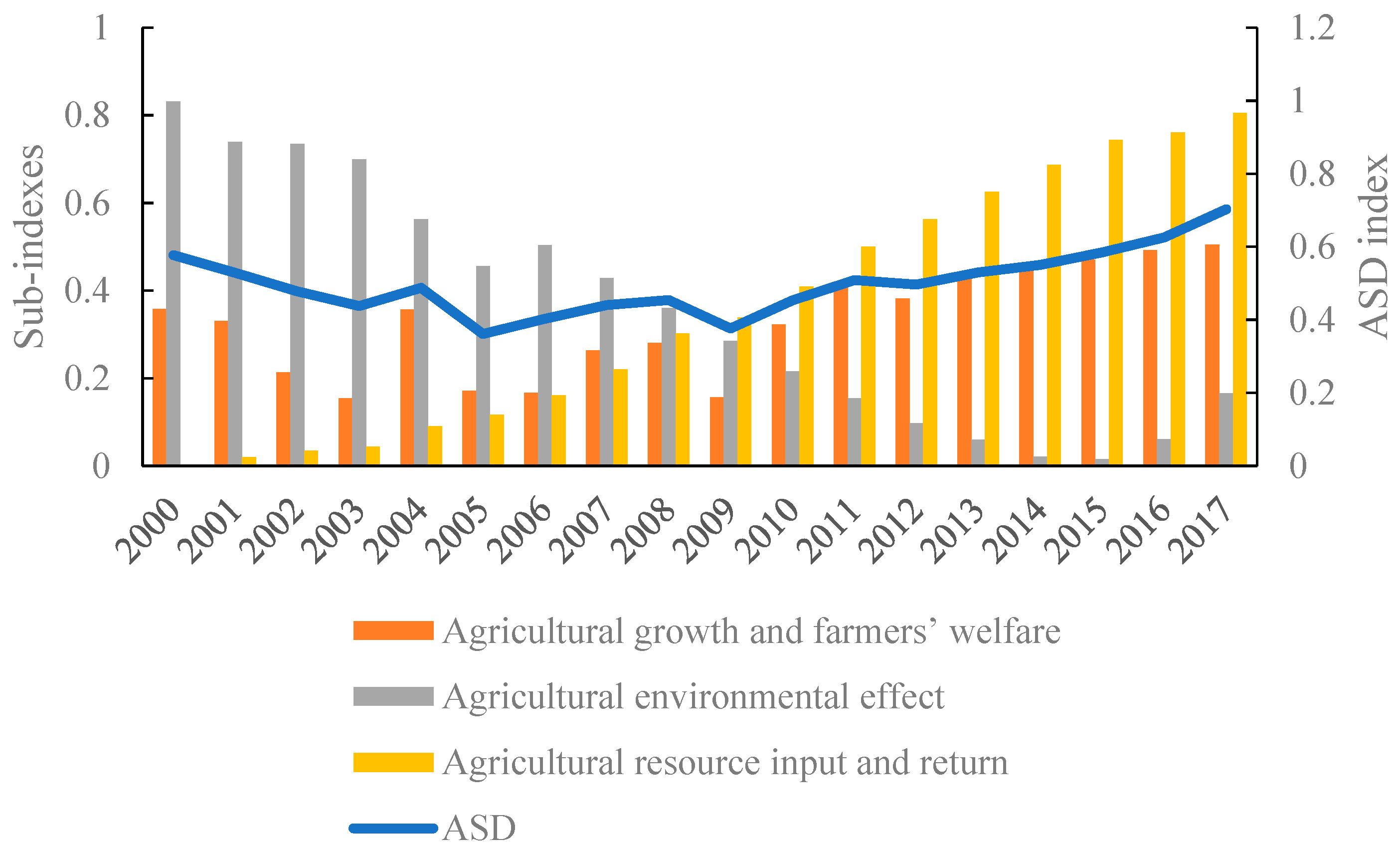
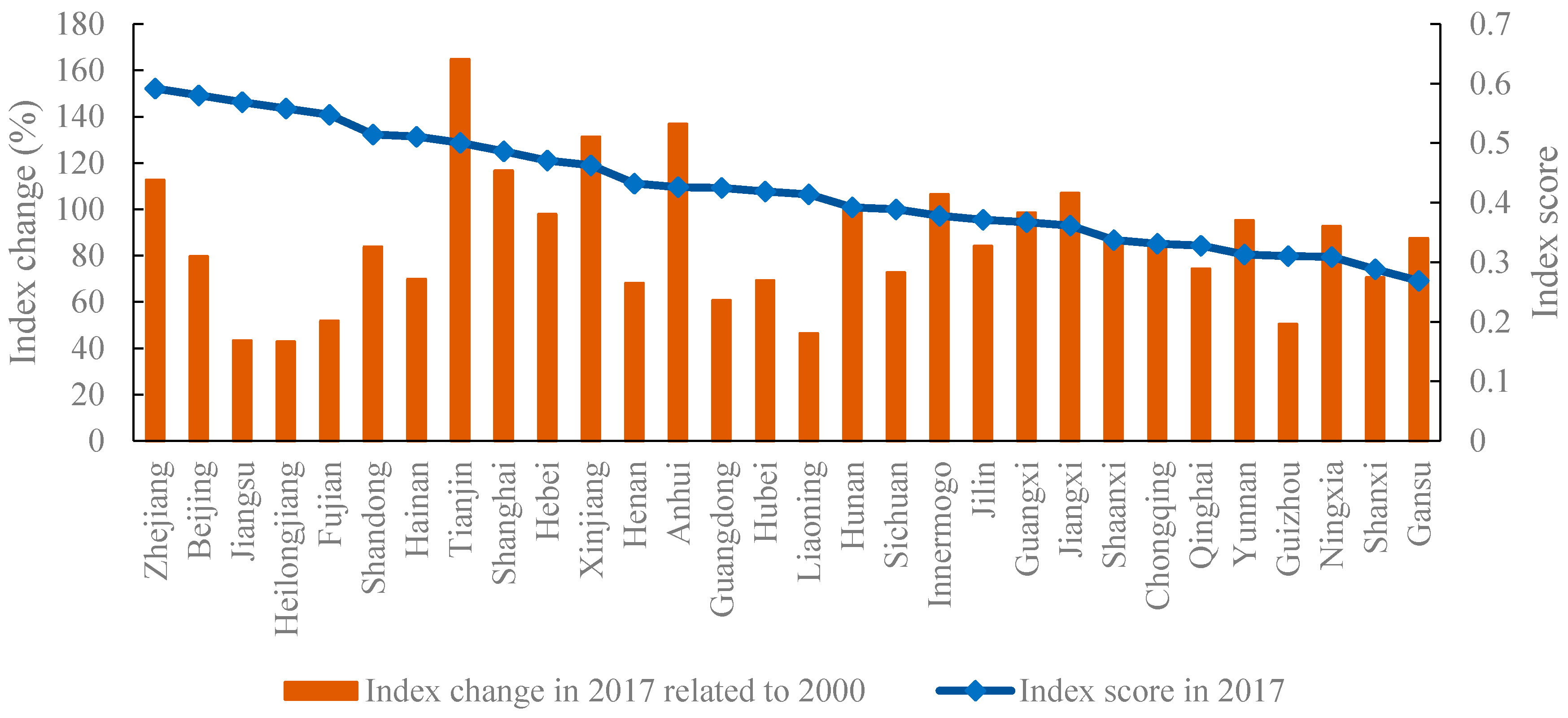

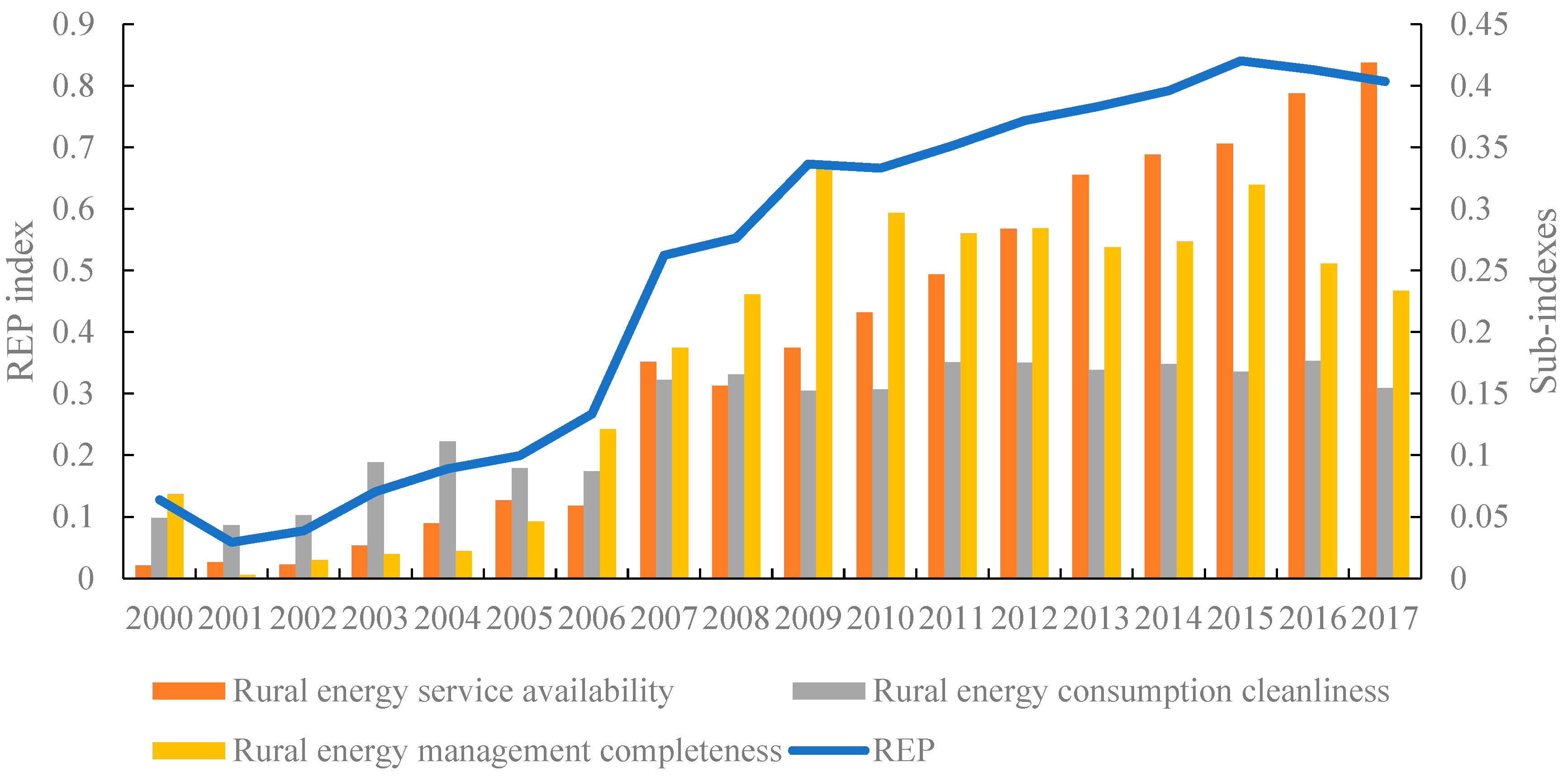
| Primary Indexes | Secondary Indexes | Measurement | Property |
|---|---|---|---|
| Agricultural growth and farmers’ welfare | Agricultural growth rate | Per capita agricultural value-added growth | Benefit |
| Proportion of agricultural value added to the gross domestic product (GDP) | Benefit | ||
| Farmers’ lives | Rural residents’ disposable income | Benefit | |
| Ratio of rural residents’ net income to urban residents’ | Benefit | ||
| Agricultural environmental effect | Agricultural input intensity | Pure equivalent chemical fertilizer application on the unit planting area | Cost |
| Pesticide application in unit planting area | Cost | ||
| Agricultural plastic film application on the unit planting area | Cost | ||
| Agricultural greenhouse effect | Agricultural carbon emissions | Cost | |
| Agricultural resource input and return | Agricultural resource utilization | Agricultural mechanical power on the unit planting area | Benefit |
| Effective irrigation area | Benefit | ||
| Agricultural productivity | Agricultural value added of unit planting area | Benefit | |
| Agricultural value added per agricultural worker | Benefit |
| Variables | Unit | Obs | Mean | Std. Dev. | Min | Max |
|---|---|---|---|---|---|---|
| ASD | - | 540 | 0.3084 | 0.0955 | 0.1559 | 0.5919 |
| REP | - | 540 | 0.7180 | 0.1413 | 0.3792 | 0.9721 |
| PGDP | CNY 10 thousand | 540 | 2.9053 | 2.2757 | 0.2742 | 13.6203 |
| FDI | USD 10 thousand | 540 | 524,930.2 | 662,402.6 | 1495 | 3,575,956 |
| UR | % | 540 | 49.3470 | 14.9821 | 23.2 | 89.6 |
| RD | CNY 10 thousand | 540 | 478,328.1 | 921,189 | 4854 | 7,412,398 |
| Variables | Pooled OLS | RE | FE | PCSE | FGLS |
|---|---|---|---|---|---|
| REP | 0.126 *** (0.039) | 0.126 *** (0.022) | 0.127 *** (0.024) | 0.037 ** (0.016) | 0.027 *** (0.004) |
| lnPGDP | 0.140 *** (0.018) | 0.140 *** (0.006) | 0.142 *** (0.007) | 0.098 *** (0.009) | 0.103 *** (0.002) |
| lnFDI | −0.002 (0.006) | −0.002 (0.003) | −0.004 (0.003) | −0.002 (0.002) | −0.002 *** (0.000) |
| lnUR | −0.183 *** (0.061) | −0.183 *** (0.024) | −0.185 *** (0.027) | −0.056 ** (0.024) | −0.103 *** (0.006) |
| lnRD | 0.019 *** (0.002) | 0.019 *** (0.002) | 0.020 *** (0.003) | 0.006 ** (0.002) | 0.004 *** (0.001) |
| Constant | 0.612 *** (0.207) | 0.612 *** (0.097) | 0.629 *** (0.117) | 0.374 *** (0.090) | 0.575 *** (0.024) |
| R2 | 0.642 | 0.642 | 0.829 | 0.861 | - |
| N | 540 | 540 | 540 | 540 | 540 |
| Tests | Statistics | p-Values |
|---|---|---|
| Pesaran CD test | 15.851 *** | 0.0000 |
| Friedman test | 95.478 *** | 0.0000 |
| Frees test | 7.918 *** | 0.0000 |
| Variables | Pooled OLS | RE | FE | PCSE | FGLS |
|---|---|---|---|---|---|
| lnELEC | 0.027 *** (0.008) | 0.027 *** (0.005) | 0.048 *** (0.006) | 0.014 *** (0.005) | 0.013 *** (0.002) |
| lnPGDP | 0.120 *** (0.017) | 0.120 *** (0.007) | 0.111 *** (0.008) | 0.093 *** (0.011) | 0.091 *** (0.003) |
| lnFDI | −0.008 (0.006) | −0.008 *** (0.003) | −0.007 *** (0.003) | −0.004 *** (0.002) | −0.005 *** (0.001) |
| lnUR | −0.160 *** (0.056) | −0.160 *** (0.024) | −0.182 *** (0.026) | −0.062 ** (0.024) | −0.077 *** (0.008) |
| lnRD | 0.016 *** (0.003) | 0.016 *** (0.002) | 0.018 *** (0.003) | 0.004 * (0.002) | 0.003 *** (0.001) |
| Constant | 0.622 *** (0.197) | 0.622 *** (0.098) | 0.586 *** (0.113) | 0.418 *** (0.097) | 0.507 *** (0.032) |
| R2 | 0.565 | 0.565 | 0.837 | 0.778 | - |
| N | 540 | 540 | 540 | 540 | 540 |
| Variables | FE | FGLS | FE | FGLS | FE | FGLS |
|---|---|---|---|---|---|---|
| RESA | −1.026 *** (0.178) | −0.264 *** (0.040) | ||||
| RECC | −0.032 (0.094) | −0.008 (0.019) | ||||
| REMC | 0.162 *** (0.025) | 0.018 * (0.008) | ||||
| lnPGDP | 0.134 *** (0.007) | 0.084 *** (0.004) | 0.142 *** (0.007) | 0.086 *** (0.004) | 0.139 *** (0.007) | 0.090 *** (0.003) |
| lnFDI | −0.008 *** (0.003) | −0.004 *** (0.001) | 0.008 *** (0.003) | −0.004 *** (0.001) | −0.004 (0.003) | −0.001 *** (0.000) |
| lnUR | −0.181 *** (0.027) | −0.121 *** (0.008) | −0.199 *** (0.028) | −0.059 *** (0.010) | −0.166 *** (0.027) | −0.082 *** (0.008) |
| lnRD | 0.018 *** (0.003) | 0.004 *** (0.001) | 0.019 *** (0.003) | 0.004 *** (0.001) | 0.022 *** (0.003) | 0.007 *** (0.001) |
| Constant | 0.944 *** (0.111) | 0.764 *** (0.034) | 0.840 *** (0.113) | 0.477 *** (0.040) | 0.579 *** (0.116) | 0.482 *** (0.027) |
| R2 | 0.830 | - | 0.819 | - | 0.834 | - |
| N | 540 | 540 | 540 | 540 | 540 | 540 |
| Variables | Major Grain-Producing Areas | Non-Major Grain-Producing Areas | ||
|---|---|---|---|---|
| FE | FGLS | FE | FGLS | |
| REP | 0.042 (0.033) | 0.012 * (0.007) | 0.213 *** (0.032) | 0.053 *** (0.004) |
| lnPGDP | 0.146 *** (0.010) | 0.126 *** (0.006) | 0.163 *** (0.010) | 0.063 *** (0.002) |
| lnFDI | −0.027 *** (0.006) | −0.009 *** (0.001) | 0.000 (0.003) | −0.003 *** (0.000) |
| lnUR | −0.075 ** (0.036) | −0.142 *** (0.010) | −0.302 *** (0.039) | 0.007 (0.006) |
| lnRD | 0.013 *** (0.004) | 0.001 (0.001) | 0.021 *** (0.003) | 0.009 *** (0.000) |
| Constant | 0.663 *** (0.158) | 0.877 *** (0.043) | 0.918 *** (0.169) | 0.108 *** (0.019) |
| R2 | 0.849 | - | 0.843 | - |
| N | 216 | 216 | 324 | 324 |
Disclaimer/Publisher’s Note: The statements, opinions and data contained in all publications are solely those of the individual author(s) and contributor(s) and not of MDPI and/or the editor(s). MDPI and/or the editor(s) disclaim responsibility for any injury to people or property resulting from any ideas, methods, instructions or products referred to in the content. |
© 2024 by the authors. Licensee MDPI, Basel, Switzerland. This article is an open access article distributed under the terms and conditions of the Creative Commons Attribution (CC BY) license (https://creativecommons.org/licenses/by/4.0/).
Share and Cite
Wang, J.; Sun, X.; Zhang, S.; Zhang, X. Does Addressing Rural Energy Poverty Contribute to Achieving Sustainable Agricultural Development? Agriculture 2024, 14, 795. https://doi.org/10.3390/agriculture14060795
Wang J, Sun X, Zhang S, Zhang X. Does Addressing Rural Energy Poverty Contribute to Achieving Sustainable Agricultural Development? Agriculture. 2024; 14(6):795. https://doi.org/10.3390/agriculture14060795
Chicago/Turabian StyleWang, Jingyi, Xiaolong Sun, Shuai Zhang, and Xuebiao Zhang. 2024. "Does Addressing Rural Energy Poverty Contribute to Achieving Sustainable Agricultural Development?" Agriculture 14, no. 6: 795. https://doi.org/10.3390/agriculture14060795
APA StyleWang, J., Sun, X., Zhang, S., & Zhang, X. (2024). Does Addressing Rural Energy Poverty Contribute to Achieving Sustainable Agricultural Development? Agriculture, 14(6), 795. https://doi.org/10.3390/agriculture14060795





